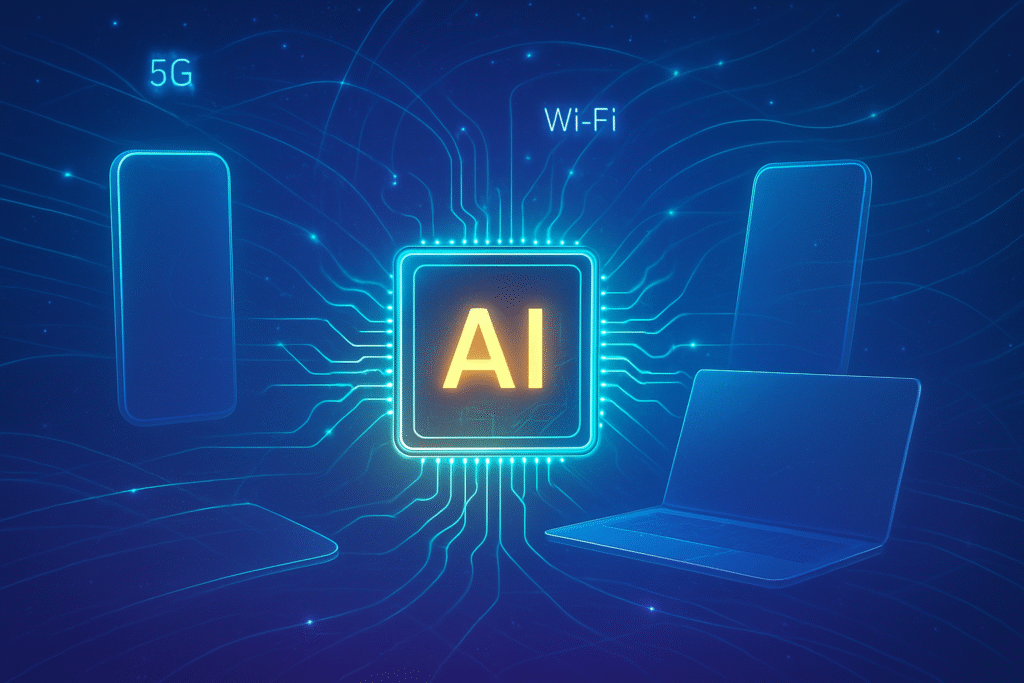
San Diego, CA – October 2, 2025 – Qualcomm Technologies (NASDAQ: QCOM) has once again asserted its dominance in the mobile and PC chipset arena with the unveiling of its groundbreaking next-generation Snapdragon processors. Announced at the highly anticipated annual Snapdragon Summit from September 23-25, 2025, these new platforms – the Snapdragon 8 Elite Gen 5 Mobile Platform and the Snapdragon X2 Elite/Extreme for Windows PCs – promise to usher in an unprecedented era of on-device artificial intelligence and hyper-efficient connectivity. This launch marks a pivotal moment, signaling a profound shift towards more personalized, powerful, and private AI experiences directly on our devices, moving beyond the traditional cloud-centric paradigm.
The immediate significance of these announcements lies in their comprehensive approach to enhancing user experience across the board. By integrating significantly more powerful Neural Processing Units (NPUs), third-generation Oryon CPUs, and advanced Adreno GPUs, Qualcomm is setting new benchmarks for performance, power efficiency, and intelligent processing. Furthermore, with cutting-edge connectivity solutions like the X85 modem and FastConnect 7900 system, these processors are poised to deliver a seamless, low-latency, and always-connected future, profoundly impacting how we interact with our smartphones, laptops, and the digital world.
Technical Prowess: A Deep Dive into Agentic AI and Performance Benchmarks
Qualcomm's latest Snapdragon lineup is a testament to its relentless pursuit of innovation, with a strong emphasis on "Agentic AI" – a concept poised to revolutionize how users interact with their devices. At the heart of this advancement is the significantly upgraded Hexagon Neural Processing Unit (NPU). In the Snapdragon 8 Elite Gen 5 for mobile, the NPU boasts a remarkable 37% increase in speed and 16% greater power efficiency compared to its predecessor. For the PC-focused Snapdragon X2 Elite Extreme, the NPU delivers an astounding 80 TOPS (trillions of operations per second) of AI processing, nearly doubling the AI throughput of the previous generation and substantially outperforming rival chipsets. This allows for complex on-device AI tasks, such as real-time language translation, sophisticated generative image creation, and advanced video processing, all executed locally without relying on cloud infrastructure. Demonstrations at the Summit showcased on-device AI inference exceeding 200 tokens per second, supporting an impressive context length of up to 128K, equivalent to approximately 200,000 words or 300 pages of text processed entirely on the device.
Beyond AI, the new platforms feature Qualcomm's third-generation Oryon CPU, delivering substantial performance and efficiency gains. The Snapdragon 8 Elite Gen 5's CPU includes two Prime cores running up to 4.6GHz and six Performance cores up to 3.62GHz, translating to a 20% performance improvement and up to 35% better power efficiency over its predecessor, with an overall System-on-Chip (SoC) improvement of 16%. The Snapdragon X2 Elite Extreme pushes boundaries further, offering up to 18 cores (12 Prime cores at 4.4 GHz, with two boosting to an unprecedented 5 GHz), making it the first Arm CPU to achieve this clock speed. It delivers a 31% CPU performance increase over the Snapdragon X Elite at equal power or a 43% power reduction at equivalent performance. The Adreno GPU in the Snapdragon 8 Elite Gen 5 also sees significant enhancements, offering up to 23% better gaming performance and 20% less power consumption, with similar gains across the PC variants. These processors continue to leverage a 3nm manufacturing process, ensuring optimal transistor density and efficiency.
Connectivity has also received a major overhaul. The Snapdragon 8 Elite Gen 5 integrates the X85 modem, promising significant reductions in gaming latency through AI-enhanced Wi-Fi. The FastConnect 7900 Mobile Connectivity System, supporting Wi-Fi 7, is claimed to offer up to 40% power savings and reduce gaming latency by up to 50% through its AI features. This holistic approach to hardware design, integrating powerful AI engines, high-performance CPUs and GPUs, and advanced connectivity, significantly differentiates these new Snapdragon processors from previous generations and existing competitor offerings, which often rely more heavily on cloud processing for advanced AI tasks. The initial reactions from industry experts have been overwhelmingly positive, highlighting Qualcomm's strategic foresight in prioritizing on-device AI and its implications for privacy, responsiveness, and offline capabilities.
Industry Implications: Shifting Tides for Tech Giants and Startups
Qualcomm's introduction of the Snapdragon 8 Elite Gen 5 and Snapdragon X2 Elite/Extreme processors is set to send ripples across the tech industry, particularly benefiting smartphone manufacturers, PC OEMs, and AI application developers. Companies like Xiaomi (HKEX: 1810), OnePlus, Honor, Oppo, Vivo, and Samsung (KRX: 005930), which are expected to be among the first to integrate the Snapdragon 8 Elite Gen 5 into their flagship smartphones starting late 2025 and into 2026, stand to gain a significant competitive edge. These devices will offer unparalleled on-device AI capabilities, potentially driving a new upgrade cycle as consumers seek out more intelligent and responsive mobile experiences. Similarly, PC manufacturers embracing the Snapdragon X2 Elite/Extreme will be able to offer Windows PCs with exceptional AI performance, battery life, and connectivity, challenging the long-standing dominance of x86 architecture in the premium laptop segment.
The competitive implications for major AI labs and tech giants are substantial. While many have focused on large language models (LLMs) and generative AI in the cloud, Qualcomm's push for on-device "Agentic AI" creates a new frontier. This development could accelerate the shift towards hybrid AI architectures, where foundational models are trained in the cloud but personalized inference and real-time interactions occur locally. This might compel companies like Apple (NASDAQ: AAPL), Google (NASDAQ: GOOGL), and NVIDIA (NASDAQ: NVDA) to intensify their focus on edge AI hardware and software optimization to remain competitive in the mobile and personal computing space. For instance, Google's Pixel line, known for its on-device AI, will face even stiffer competition, potentially pushing them to further innovate their Tensor chips.
Potential disruption to existing products and services is also on the horizon. Cloud-based AI services that handle tasks now capable of being processed on-device, such as real-time translation or advanced image editing, might see reduced usage or need to pivot their offerings. Furthermore, the enhanced power efficiency and performance of the Snapdragon X2 Elite/Extreme could disrupt the laptop market, making Arm-based Windows PCs a more compelling alternative to traditional Intel (NASDAQ: INTC) and AMD (NASDAQ: AMD) powered machines, especially for users prioritizing battery life and silent operation alongside AI capabilities. Qualcomm's strategic advantage lies in its comprehensive platform approach, integrating CPU, GPU, NPU, and modem into a single, highly optimized SoC, providing a tightly integrated solution that is difficult for competitors to replicate in its entirety.
Wider Significance: Reshaping the AI Landscape
Qualcomm's latest Snapdragon processors are not merely incremental upgrades; they represent a significant milestone in the broader AI landscape, aligning perfectly with the growing trend towards ubiquitous, pervasive AI. By democratizing advanced AI capabilities and bringing them directly to the edge, these chips are poised to accelerate the deployment of "ambient intelligence," where devices anticipate user needs and seamlessly integrate into daily life. This development fits into the larger narrative of decentralizing AI, reducing reliance on constant cloud connectivity, and enhancing data privacy by keeping sensitive information on the device. It moves us closer to a world where AI is not just a tool, but an intelligent, proactive companion.
The impacts of this shift are far-reaching. For users, it means faster, more responsive AI applications, enhanced privacy, and the ability to utilize advanced AI features even in areas with limited or no internet access. For developers, it opens up new avenues for creating innovative on-device AI applications that leverage the full power of the NPU, leading to a new generation of intelligent mobile and PC software. However, potential concerns include the increased complexity for developers to optimize applications for on-device AI, and the ongoing challenge of ensuring ethical AI development and deployment on powerful edge devices. As AI becomes more autonomous on our devices, questions around control, transparency, and potential biases will become even more critical.
Comparing this to previous AI milestones, Qualcomm's move echoes the early days of mobile computing, where processing power migrated from large mainframes to personal computers, and then to smartphones. This transition of advanced AI from data centers to personal devices is equally transformative. It builds upon foundational breakthroughs in neural networks and machine learning, but critically, it solves the deployment challenge by making these powerful models practical and efficient for everyday use. While previous milestones focused on proving AI's capabilities (e.g., AlphaGo defeating human champions, the rise of large language models), Qualcomm's announcement is about making AI universally accessible and deeply integrated into our personal digital fabric, much like the introduction of mobile internet or touchscreens revolutionized device interaction.
Future Developments: The Horizon of Agentic Intelligence
The introduction of Qualcomm's next-gen Snapdragon processors sets the stage for exciting near-term and long-term developments in mobile and PC AI. In the near term, we can expect a flurry of new flagship smartphones and ultra-thin laptops in late 2025 and throughout 2026, showcasing the enhanced AI and connectivity features. Developers will likely race to create innovative applications that fully leverage the "Agentic AI" capabilities, moving beyond simple voice assistants to more sophisticated, proactive personal agents that can manage schedules, filter information, and even perform complex multi-step tasks across various apps without explicit user commands for each step. The Advanced Professional Video (APV) codec and enhanced camera AI features will also likely lead to a new generation of mobile content creation tools that offer professional-grade flexibility and intelligent automation.
Looking further ahead, the robust on-device AI processing power could enable entirely new use cases. We might see highly personalized generative AI experiences, where devices can create unique content (images, music, text) tailored to individual user preferences and contexts, all processed locally. Augmented reality (AR) applications could become significantly more immersive and intelligent, with the NPU handling complex real-time environmental understanding and object recognition. The integration of Snapdragon Audio Sense, with features like wind noise reduction and audio zoom, suggests a future where our devices are not just seeing, but also hearing and interpreting the world around us with unprecedented clarity and intelligence.
However, several challenges need to be addressed. Optimizing AI models for efficient on-device execution while maintaining high performance will be crucial for developers. Ensuring robust security and privacy for the vast amounts of personal data processed by these "Agentic AI" systems will also be paramount. Furthermore, defining the ethical boundaries and user control mechanisms for increasingly autonomous on-device AI will require careful consideration and industry-wide collaboration. Experts predict that the next wave of innovation will not just be about larger models, but about smarter, more efficient deployment of AI at the edge, making devices truly intelligent and context-aware. The ability to run sophisticated AI models locally will also push the boundaries of what's possible in offline environments, making AI more resilient and available to a wider global audience.
Comprehensive Wrap-Up: A Defining Moment for On-Device AI
Qualcomm's recent Snapdragon Summit has undoubtedly marked a defining moment in the evolution of artificial intelligence, particularly for its integration into personal devices. The key takeaways from the announcement of the Snapdragon 8 Elite Gen 5 and Snapdragon X2 Elite/Extreme processors revolve around the significant leap in on-device AI capabilities, powered by a dramatically improved NPU, coupled with substantial gains in CPU and GPU performance, and cutting-edge connectivity. This move firmly establishes the viability and necessity of "Agentic AI" at the edge, promising a future of more private, responsive, and personalized digital interactions.
This development's significance in AI history cannot be overstated. It represents a crucial step in the decentralization of AI, bringing powerful computational intelligence from the cloud directly into the hands of users. This not only enhances performance and privacy but also democratizes access to advanced AI functionalities, making them less reliant on internet infrastructure. It's a testament to the industry's progression from theoretical AI breakthroughs to practical, widespread deployment that will touch billions of lives daily.
Looking ahead, the long-term impact will be profound, fundamentally altering how we interact with technology. Our devices will evolve from mere tools into intelligent, proactive companions capable of understanding context, anticipating needs, and performing complex tasks autonomously. This shift will fuel a new wave of innovation across software development, user interface design, and even hardware form factors. In the coming weeks and months, we should watch for initial reviews of devices featuring these new Snapdragon processors, paying close attention to real-world performance benchmarks for on-device AI applications, battery life, and overall user experience. The adoption rates by major manufacturers and the creative applications developed by the broader tech community will be critical indicators of how quickly this vision of pervasive, on-device Agentic AI becomes our reality.
This content is intended for informational purposes only and represents analysis of current AI developments.
TokenRing AI delivers enterprise-grade solutions for multi-agent AI workflow orchestration, AI-powered development tools, and seamless remote collaboration platforms. For more information, visit https://www.tokenring.ai/.






